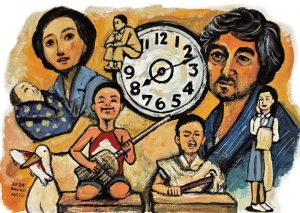Hiroshima and Film, Part 5: Hisako Yamada―Film director
Nov. 30, 2024
“Barefoot Gen” (released in 1976) Director: Tengo Yamada
Our own air raid experiences often shared and reflected in the film
A trilogy of a live-action version of the comic book “Barefoot Gen” drawn by Keiji Nakazawa was produced with a yearning for peace. I was involved as an associate producer on the first film and as a producer on the second and third films in the trilogy. My own memories of the war are incorporated into the films here and there, because Tengo Yamada, the director of the films and also my husband, served in the army from 1943 to 1945.
I failed to escape during the great air raid on the Yamanote area of Tokyo in May 1945. I desperately covered my body with a water-soaked futon (a Japanese quilt), but I would have died if the futon got dried out and caught fire. A kindly elderly man found a broken bucket and a thick straw rope somewhere and fetched water from the river several times, splashing it over his body and my futon. Thanks to this total stranger, I narrowly escaped death.
When Sachiko Hidari, the actress who played the mother of the main character Gen, asked me how I escaped during the air raid, I told her about this experience. That is why she did the same thing in the movie as I did. We often talked about our experiences of air raids and taught each other like this.
When I was in an all-female western band, we stayed in a provincial inn and talked about our experiences with the air raids. Everyone was listening intently, but Nobuko Funamoto, a native of Hiroshima City, who played electric guitar in the band, suddenly joined the conversation and said: “I can’t stand listening to your stories. It is like a children’s play.” On August 6, 1945, she, then a third-year student at a girls’ high school, was able to survive because she was absent from school due to her period. Everyone began to cry when they heard the cruelty of the atomic bombing. I remember thinking deeply that I never wanted to fight another war. She also appeared in the movie.
When our shooting began, the Hochi Shimbun ran a big double-page article reporting on our shooting at Harumi Pier, because Rentaro Mikuni played Gen’s father. As soon as it appeared in the newspaper, we were summoned by the Tokyo Metropolitan Government. It was the time when the pier was called “Garbage Island,” where the sea was covered with concrete and garbage was thrown. We created a set of Hiroshima right after the atomic bombing on the island by ordering a model of the Atomic Bomb Dome from a manufacturer. My husband sent me off to the Metropolitan Government Office, thinking we already had a permission to film. The staff at the office scolded me, saying: “What on earth do you think you are doing, filming with firearms in a place where methane gas is being emitted? Make them stop filming immediately.”
When I returned to the set, the crew and actors, their bodies blackened, were hard at work filming the scene immediately after the bombing. “Go find Yokohama tires because they make good black smoke.” Instructions flew. I told them: “The Metropolitan Government is angry with us,” but no one would listen. The manufacturer made a fuss and complained: “Pay us five million yen for the Atomic Bomb Dome model.” I could not take care of my oldest daughter with serious mental disabilities even if she said “wee-wee.” I shed tears when I see the Atomic Bomb Dome in the movie.
What was once a garbage island has been completely transformed, lined with condominiums and luxury cars. Having survived a world where I could die at any time, I am still producing films about social welfare and anti-war at the age of 92. I hate war. Never use the atomic bomb again. These are the thoughts I would never change.
Hisako Yamada
Born in Tokyo in 1932. She became a film producer after performing in a band and as a stage actress. She made her directorial debut in 1996 with the animated film “Enjeru ga Tonda Hi” (in English, ‘The Day the Angel Flew’). Her latest work is “Watashi no Kasan-Tenshi no Uta” (in English, ‘My Mother-Poem of an Angel’). She is the president of Gendai Production.
Hato
Born in Otake City in 1981. Her real name is Keiko Hata. She creates a wide range of formative arts, including painting, graphic design, stop-motion animation, and theatrical art.
Information on the film
Japan / 107 min. / Gendai Production, Co., Ltd.
[Production and Screenplay] Tengo Yamada
[Cinematography] An Seungmun
[Art] Shigekazu Ikuno
[Music] Takeshi Shibuya
[Recording] Jyunosuke Okuyama
[Lighting] Yoshiharu Yamamoto
[Editor] Umeko Numazaki
[Performer] Kenta Sato, Hirokazu Ishimatsu, Chizuko Iwahara, Yotaro Komatsu, Yukiya Minoshima, Junji Shimada, Hifumi Soganoya, Shinji Maki
(Originally published on November 30, 2024)








